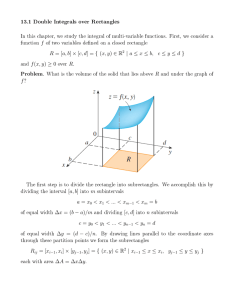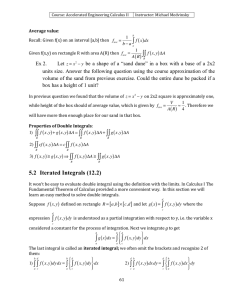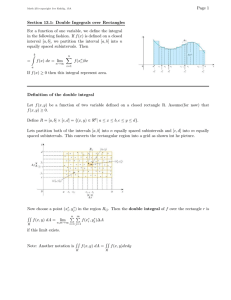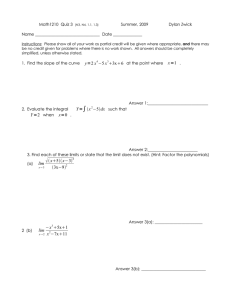Document 12133446
advertisement
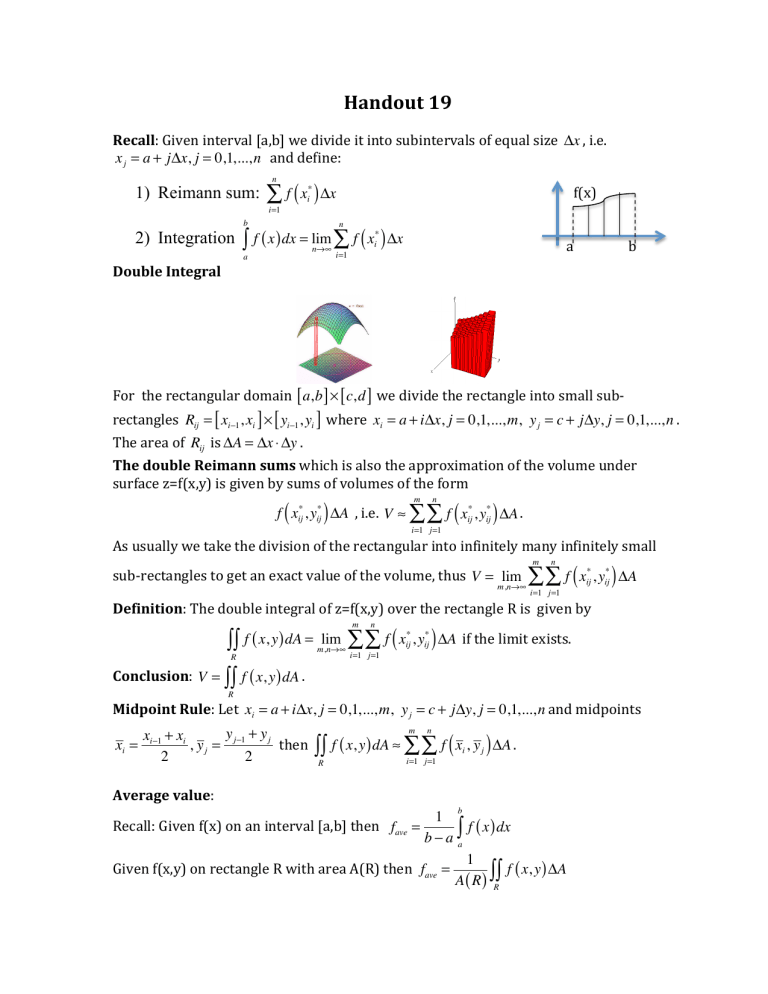
Handout 19 Recall: Given interval [a,b] we divide it into subintervals of equal size Δx , i.e. x j = a + jΔx, j = 0,1,...,n and define: 1) Reimann sum: n ∑ f ( x ) Δx f(x) * i i=1 2) Integration b ∫ n f ( x ) dx = lim ∑ f ( xi* ) Δx n→∞ a a i=1 b Double Integral For the rectangular domain [ a,b ] × [ c,d ] we divide the rectangle into small sub-­‐ rectangles Rij = [ xi−1 , xi ] × [ yi−1 , yi ] where xi = a + iΔx, j = 0,1,..., m, y j = c + jΔy, j = 0,1,...,n . The area of Rij is ΔA = Δx ⋅ Δy . The double Reimann sums which is also the approximation of the volume under surface z=f(x,y) is given by sums of volumes of the form ( ) m ( n ) f xij* , yij* ΔA , i.e. V ≈ ∑ ∑ f xij* , yij* ΔA . i=1 j=1 As usually we take the division of the rectangular into infinitely many infinitely small sub-­‐rectangles to get an exact value of the volume, thus V = lim m,n→∞ ∑ ∑ f ( x , y ) ΔA m n * ij * ij i=1 j=1 Definition: The double integral of z=f(x,y) over the rectangle R is given by ∫∫ f ( x, y ) dA = lim R m,n→∞ ∑ ∑ f ( x , y ) ΔA if the limit exists. m n * ij * ij i=1 j=1 Conclusion: V = ∫∫ f ( x, y ) dA . R Midpoint Rule: Let xi = a + iΔx, j = 0,1,..., m, y j = c + jΔy, j = 0,1,...,n and midpoints xi = m n y + yj xi−1 + xi then ∫∫ f ( x, y ) dA ≈ ∑ ∑ f xi , y j ΔA . , y j = j−1 2 2 i=1 j=1 R ( ) Average value: b 1 f ( x ) dx b − a ∫a 1 Given f(x,y) on rectangle R with area A(R) then fave = f ( x, y ) ΔA A ( R ) ∫∫ R Recall: Given f(x) on an interval [a,b] then fave = Properties of Double Integrals: 1) ∫∫ f ( x, y ) + g ( x, y ) ΔA = ∫∫ f ( x, y ) ΔA + ∫∫ g ( x, y ) ΔA R R R 2) ∫∫ cf ( x, y ) ΔA = c ∫∫ f ( x, y ) ΔA R R 3) f ( x, y ) ≥ g ( x, y ) ⇒ ∫∫ f ( x, y ) ΔA ≥ ∫∫ g ( x, y ) ΔA R R Iterated Integrals: d Suppose f ( x, y ) defined on rectangle R = [ a,b ] × [ c,d ] and let g ( x ) = ∫ f ( x, y ) dy where c d the expression ∫ f ( x, y ) dy is understood as a partial integration with respect to y, i.e. the c variable x considered a constant for the process of integration. Next we integrate g to get b b d ⎧ ⎫ ∫a g ( x ) dx = ∫a ⎨⎩⎪ ∫c f ( x, y ) dy ⎬⎭⎪ dx The last integral is called an iterated integral; we often omit the brackets and recognize 2 of them: b d b d b d ⎧d ⎫ ⎧b ⎫ 1) ∫ ∫ f ( x, y ) dy dx = ∫ ⎨ ∫ f ( x, y ) dy ⎬ dx 2) ∫ ∫ f ( x, y ) dx dy = ∫ ⎨ ∫ f ( x, y ) dx ⎬ dy ⎪c ⎪a a c a ⎩ c a c ⎩ ⎭⎪ ⎭⎪ Theorem (Fubini’s): If f(x,y) is continuous on rectangle R = [ a,b ] × [ c,d ] (or at least bounded with discontinuities on a finite number of smooth curves) then ∫∫ R b d d b a c c a f ( x, y ) dA = ∫ ∫ f ( x, y ) dy dx = ∫ ∫ f ( x, y ) dy dx Thm: Let f(x,y) = g(x)h(y) then b d b d b d a c a c a c ∫ ∫ f ( x, y ) dy dx = ∫ ∫ g ( x ) h ( y ) dy dx = ∫ g ( x ) dx ⋅ ∫ h ( y ) dy d b d b b d c a c a a c ∫ ∫ f ( x, y ) dx dy = ∫ ∫ g ( x ) h ( y ) dx dy = ∫ g ( x ) dx ⋅ ∫ h ( y ) dy
